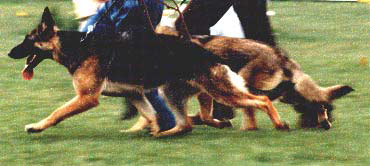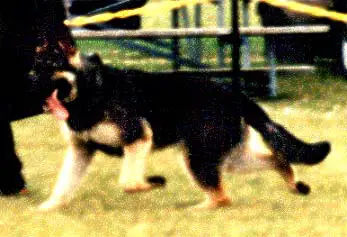
This is a placeholder text
Group text
by Ibrahim on 02 June 2012 - 20:06
The dogs below show the problems of straightening rear legs to get full drive. The near one has a steep croup. Also notice the front leg angle, indicating lack of shoulder layback.

angle at the knee; at the point of greatest push and the forward movement of the leg. This is associated with the above noted toe curling and dragging the top of the foot. Some contend that the extreme angulation results from a disproportionate longer lower leg between the stifle and the hock joint. It is
not disputed at this time but know that by steepening the pelvis we are in effect, lengthening the effect of the thighbone, and increasing angulation. The search should now be on to find dogs that do fully straighten the bones of the femur and tibia fibula into one unit at the point the dog pushes forward. This locks in the kneecap as an extra stabilizer. A clue as to where to find the desired characteristics is to look for a long properly angled pelvis. The follow through from the hock down will likely come along, finishing close to the ground. Now let's move forward with the push. As the drive is taken through the straight column of bones of the rear into the firm level back, the push is forward without roll sway or roach. There is some argument, that comes through the German authorities, supporting the idea of less rear with the roached back allowing for greater forward reach of the hind end. My slow motion studies of the German dogs indicate however that there is a straightening of the topline at the point of final push, which also lessens the angle of the pelvis allowing for a smoother and more definite follow through. This action is in some way similar to that of the sight hounds such as th
by Ibrahim on 02 June 2012 - 20:06
and pasterns is more likely to withstand the rigors of the work they are expected to do. The let down pastern is an American fashion development. It goes with flipping pasterns and feet. A look back confirms it was not an original design. Similarly, the better working dog usually has a better shoulder. The 45-degree angle of shoulder is the proclaimed ideal. What are we talking about? Simply it is the angle that the shoulder blade lays back on the body and is determined simply by placing one finger on the point of the shoulder and running the other hand up the spine of the blade to the top of the blade and looking at the angle created, off the perpendicular or horizontal. The best would be the same. A 45-degree angle is seldom seen. A simple geometric plastic protractor will show just what 45 degrees is. The significance of the well laid back shoulder is shown in the way the front moves. A dog with the blade angled off the perpendicular less than the 45 desired will proportionately land with the foreleg more vertically into the ground causing greater stress. A let down pastern is an indication of loose ligamentation that adds to the problem rather than cushion the landing. The angle of the foreleg when the
foot touches the ground is parallel to the angle of the extended imaginary line of the shoulder blade. Consequently, the well laid back shoulder allows for a more gradual angle and thus shock absorption as the foot touches the ground then proceeds to take the weight of the dog. Look back to the dog pictured in full stride, two pages back, then look at the dogs pictured on the next page. This is a study if you want to understand you have to spend time studying pictures.
by Ibrahim on 02 June 2012 - 20:06

The dog above reaches poorly in front, is soft in the pasterns, lacks follow through behind but reaches well under with hind legs. The one to the side has no reach, short upper arm, drives front leg into the ground, has no reach or drive in the rear and with all this, it is balanced and going nowhere. Note the lifting and curling.

The upper arm is more likely to have the desired angle than the shoulder blade but it also must have length. It must have enough length to bring the foreleg it is attached to directly under the upper tip of the blade. When the upper arm or humorous swings forward it usually extends to a point slightly beyond the vertical in the best examples. The length brings the elbow closer to the ground, which will make the angle of the foreleg more horizontal as it reaches forward. Extension of the upper-arm beyond the vertical indicates ligament looseness and does not take the weight as well. If the upper arm balances the angle of the shoulder the foot will hit the ground, at the point of full extension, in the best examples, in unison with the alternate rear foot. The whole dog can still appear balanced, if both upper arm and blade are short and not well angled, if not driven by a well angled or properly moving rear. If the upper arm is shorter than the blade the angle will be less and at full extension the foot will be above the ground and have to drop, an almost hackney wasted motion. If the upper arm is long on a less angled laid back shoulder, the front foot reaches forward in an upward arc, pawing the air before landing.
by Ibrahim on 02 June 2012 - 20:06

The ideal front will contain flat muscles on the outer side of the well laid back blade, The upper arm will slope back at an identical angle and the closer the two angles together approximate 90 degrees the more efficient the front will operate. As the dog reaches forward, whether moving fast or slow, it will reach forward close to the ground, place the foot on the ground at the point of full extension, then give somewhat on a strong pastern, the angle of the foreleg will not be a steep angle and will match that of the laid back shoulder. At a faster speed the upper arm and blade angle will open as the arm swings forward and the blade swings back, the angle of the foreleg as the foot hits the ground will be the same angle that the blade is laid back at that point. As the front leg follows through, pasterns that flip right up behind the leg are an indication to look for softness in landing. The ligamentation is weak. As with the rear, a smooth follow through close to the ground is the ideal, but often missed. Look at the ideal dog picture. This is the tie in of structure and movement. Some dogs will have less than desired angles but may display an outstanding balance of movement. There are various reasons why dogs do not move true but with the German Shepherd an over reach of the rear is actually desired which makes the legs not usually move in a true one behind the other line. However both hind legs on either side of both front legs is an indication
by joanro on 02 June 2012 - 20:06
by Ibrahim on 02 June 2012 - 20:06


by Ibrahim on 02 June 2012 - 21:06
http://www.angelplace.net/doc/GarrettBook.pdf
by Gustav on 02 June 2012 - 21:06
by SitasMom on 03 June 2012 - 14:06
The END result of what
If in the course of the pursuit of singular aspects of the breed,
Its really very simple....this is the only way to ultimately measure the worth of what
Sure, all pups won't become working dogs we understand that, but if the essence of
Gustav - please define "working dog" and "real working world".
by SitasMom on 04 June 2012 - 00:06
After pm'ing with Gustav......he (falsely) believes that the only thing a GSD can do that is work is "police work".
So now we all know where he's coming from.........small vision......very small.....
Contact information Disclaimer Privacy Statement Copyright Information Terms of Service Cookie policy ↑ Back to top




